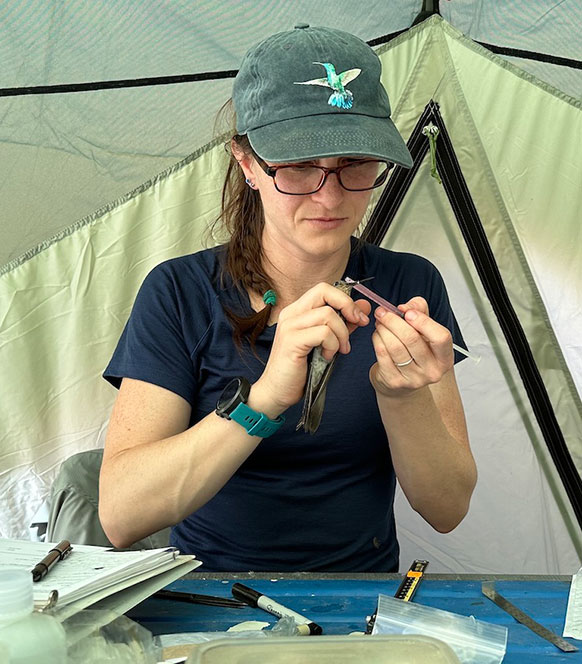
Jessie Williamson, an assistant professor in the UW Department of Zoology and Physiology, takes a pollen sample from a northern giant hummingbird (Patagona peruviana) during research in Peru. Williamson recently received a four-year, $1.066 million grant from the National Science Foundation to study how two species of giant hummingbirds respond to extreme environments in the high-elevation Andes Mountains of Peru and Bolivia. (Kyana Montoya Photo)
Jessie Williamson wants to understand how mountain hummingbirds, specifically two species, respond to extreme environments in the high-elevation Andes Mountains of Peru and Bolivia.
To further that agenda, Williamson, an assistant professor in the UW Department of Zoology and Physiology, received a four-year research grant from the National Science Foundation (NSF), in the amount of $1.066 million, for her project titled “Genomic and eco-physiological mechanisms of hypoxia resistance in mountain hummingbirds.” The grant, awarded from NSF’s Division of Integrative Organismal Systems, begins Dec. 15 and continues through Nov. 30, 2029.
Williamson will serve as the grant’s sole principal investigator and lead a research team that will study the high-elevation resident northern giant hummingbird (Patagona peruviana) and the elevational migrant southern giant hummingbird (P. gigas), of which some populations shift seasonally from sea level to over 13,400 feet in elevation -- much higher than Medicine Bow Peak.
High elevations impose extreme physiological stress on these hummingbirds due to cold temperatures and oxygen scarcity, which is known as hypoxia.
“High elevations push organisms to their physiological limits. Yet, mountains are biodiversity hotspots worldwide,” Williamson says. “I study how birds cope with challenging high-elevation environments and how species adaptations contribute to shaping patterns of biodiversity.”
Williamson and her team will conduct experiments in the field in Peru to understand how individual hummingbirds respond to shifts in temperature and oxygen pressure, and will collect data on blood physiology, gene expression and behavior. Her team also will sequence hundreds of whole genomes from giant hummingbirds to understand how they are adapted to specific environmental conditions.
“An exciting component of this grant is that we will then synthesize these integrative and complementary datasets to generate spatial forecasts of adaptive capacity across the Andes,” Williamson says. “Ultimately, these predictive maps will tell us whether, and how, some populations are more resilient than others to current and future environmental change.”
This grant work will build on nearly a decade of research already conducted by Williamson and her research team that involved using a combination of whole genome sequencing, migration tracking with miniaturized “backpack” devices, and analyses of blood physiology and morphology.
The northern and southern giant hummingbird species are the largest hummingbirds in the world, about 10 times larger than the tiny broad-tailed hummingbirds that zoom around backyards in Wyoming, Williamson says.
The grant will support two new UW graduate students -- Margaret Hemp, a first-year Ph.D. student from Jamestown, R.I.; and Collin Porter, a first-year Ph.D. student from Williamsport, Pa. The grant also includes funding to support UW undergraduate students during the school year and summer, as well as funding to support a postdoctoral researcher.
Additionally, the NSF grant will support educational outreach. The research will provide hands-on molecular lab, bioinformatics and field training for early-career scientists. It will involve close partnerships with collaborators at the Centro de Ornitología y Biodiversidad in Peru and the Museo de Historia Natural Noel Kempff Mercado in Bolivia.
“Our team of students and researchers from UW, Peru and Bolivia will offer skill-building workshops and teach biodiversity-focused educational units,” Williamson explains. “This grant also will enable us to grow museum collections and build natural history infrastructure in the U.S. and South America.”
“This grant provides a critical foundation from which to start my lab here at UW,” Williamson continues. “It will allow me to pursue ambitious questions at the intersection of ecology, evolution and physiology; build a collaborative team; train the next generation of scientists; and contribute to natural history museums and education in meaningful ways. I am very grateful to NSF for supporting our research, and I could not be more excited to get started.”

